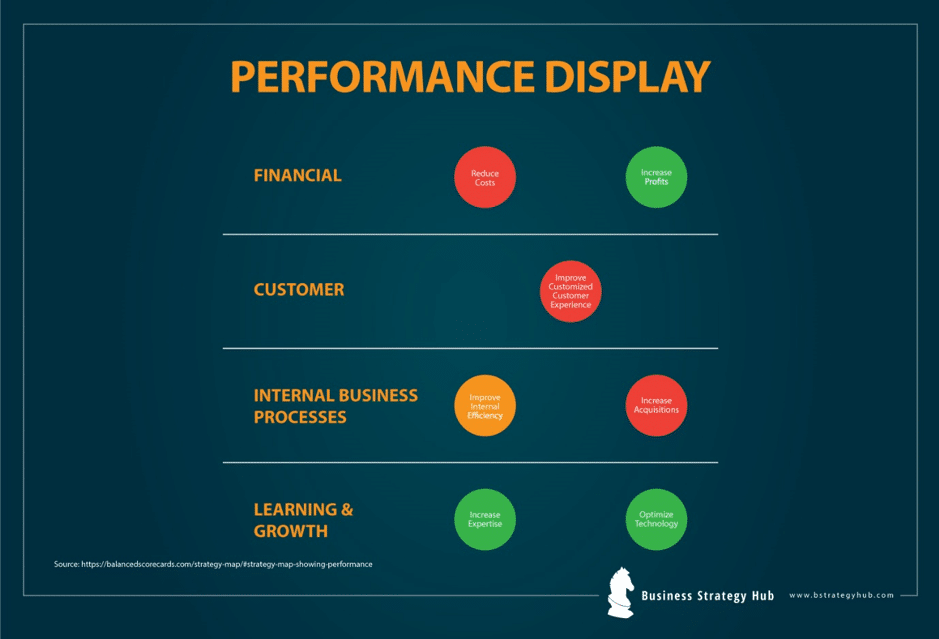Model Name : Strategy Maps
Creator : Dr. Robert S. Kaplan and Dr. David P. Norton
Year : 2004
Purpose : Setting strategic goals | Cause-and-effect relationships |Strategic planning | Performance management| Organizational strategy
Business leaders and managers at the helm of any situation understand that strategizing is crucial for the success of their trade. A great many methods, tools, and techniques have been developed by management experts to help business professionals devise their strategies competently.
You also use many strategy techniques and instruments every day in your organization according to the needs and demands of the current business situation. Every tool is distinct in its features and attributes.
However, one particular tool is outstanding in its aptitude. This well-depicted visualization helps you and your team understand your business in a transparent, detailed and comprehensive manner. No other tool gives you that much precise insights about your company!
This visualization tool is what we call a ‘Strategy Map.’
What is Strategy Map?
The concept of ‘strategy maps’ was originated by Dr. Robert S. Kaplan and Dr. David P. Norton when they pioneered the idea of Balanced Scorecard in their book “The Balanced Scorecard, Translating Strategy into Action.”So, before moving to strategy maps, it is essential to understand the balanced scorecard.
What is Balanced Scorecard?
A balanced scorecard is a measuring framework to evaluate the overall organizational performance by identifying internal and external operations. It highlights the four primary aspects of the organization including :
- Finance
- Marketing
- Internal business processes
- Organizational development
Now, you may ask;
What is the connection between balanced scorecard and strategy maps?
When organizations design balanced scorecard to analyze their performance and management system capabilities, they encountered a challenge in decision-making. There are numerous activities, operations, and outcomes in an organization which are necessary to monitor, but which activity should be monitored first and which later, is a difficult question to answer for every company.
Prioritization has been the main issue
Thus, this created a need for developing something visualized, preferably in a ‘mapping’ form that would show the big picture of the organization at a glance.
Strategy mapping took its birth in the shape of ‘diagrams’ that help in understanding the organization’s activities easily.
It became a useful tool for managers to decide what objectives and strategies need to be focused and hence, selected. With the help of arrows and infusing the colors into the strategic goals, you can easily develop your company’s strategy map to get a clear vision of your performance through these objectives.
Take a look at the following examples of strategy map:

Image Source: www.balancedscorecards.com
In this figure, you can vividly see the connection between the objectives and how a bigger objective can be achieved by focusing on lower objectives or goals.
You can also highlight a specific objective with various colors. Moreover, in this way, you have a better idea about your performance measures and goals to be achieved.
For example, red color delineates that immediate attention is required to report that matter. Below is an example:

Image Source: www.balancedscorecards.com
Why We Should Create Strategy Maps?
A clear direction is necessary for everyone including the company’s managers and employees to know what they are working on and what goals to accomplish to increase their productivity.
This is what a strategy map does. With this map, you can simply convey your entire ‘story’ of the organization to your employees, shareholders and business partners and they will know what they are required to do and how to contribute to the organization with their performance and commitment.
When you have included your strategic objectives on a map and associated a link between them through arrows, you will see a cause-and-effect relationship between those goals.
As soon as you know the relationship, you can gauge the importance of one goal in attaining the other goals. This will help you in devising your action plan, and consequently developing your overall strategy according to your organization’s targets. You will also be able to monitor and control the implementation of your strategy.
What is the benefit of Strategy maps?
Following are the benefits that will depict the significance of creating strategy maps for the successful performance of an organization:
- It enables you to evaluate your organization’s performance on a single page and how you can increase it.
- It allows you to look deeper into the individual elements in creating the strategy and how these elements are related to each other.
- It helps you to identify the short-term objectives that will lead you to the development of the long-term strategies.
- It assists you in the clarification of different goals and tasks, enabling them to perform efficiently.
- It gives you a clearer path to realize the individuals’ roles and responsibilities in the organization.
- You can manage your risks and potential threats through strategy mapping. With the quick scanning of the map, you can detect your lacks, weaknesses, and issues to deal in advance.
- You can develop effective solutions relevant to your organization’s aims and objectives through strategy mapping.
Step to develop your own Strategy Map
A strategy map can be developed with the help of six stages. These are as follows:
- The first and foremost stage is to identify your most important objectives by answering ‘what do you want to achieve?’
- Secondly, recognize your value proposition so that you can provide utmost value to your customers and ultimately, become a market leader.
- Now, you need to choose your financial goals. For example, reducing costs, growing sales and maximizing investments are pivotal financial goals to achieve.
- At this stage, develop the strategies for your customers. Improving brand awareness, augmenting customer experience, and building strong relationships with your customer are a few examples to put in customers’ strategies.
- Now, analyze your internal business processes and execute accordingly like gathering market knowledge, innovating your products, and enhancing internal productivity.
- Lastly, plan and develop the learning and growth strategies for your organization. This may include implementing training sessions, executing an IT program, or improving internal communication.
Final Thought
Going through these six stages, you can create a strategy map that will rigorously guide you throughout your company’s progress and performance.
Now you know the importance and procedure of strategy mapping, you should definitely develop it as soon as possible to accomplish your organizational goals and objectives.
References & more information












Highly informative article, I liked it alot.
Great article.